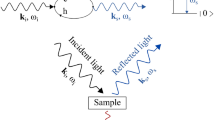Abstract
In this paper, we describe the analysis of strained-Si device including quantum effect. We linked the first principle band calculation program to the FUJITSU ensemble full band Monte Carlo simulator FALCON directly, which enables to take in arbitrary biaxial strained-Si band structure easily. And also the quantum effect was implemented by Bohm potential method. We show that the strain effect decreases with scaling to 10 nm gate length regime. However, in the domain which ballistic particle is majority, the effect of strain becomes useful again by the increase of the velocity by strain at the source region. This becomes more remarkable when quantum effect is taken into account.
Similar content being viewed by others
References
D.K. Ferry, R. Akis, and D. Vasileska, “Quantum effects in MOSFETs: Use of an effective potential in 3D Monte Carlo simulation of ultra-short channel devices,” IEDM Tech Dig., 287, 2000.
M. Ogawa, H. Tsuchiya, and T. Miyoshi, “Quantum electron transport modeling in nano-scale devices,” IEICE Trans. Electron., E83-C(3), 363 (2003).
B. Wu, T.W. Tang, J. Nam, and M.J. Tsai, “Monte Carlo simulation of symmetric and asymmetric double-gate MOSFETs using bohm-based quantum correction,” in the Proceedings of IWCE-9, 42, 2003.
K. Rim, K. Chan, L. Shi, D. Boyd, J. Ott, N. Klymko, F. Cardone, L. Tai, S. Koester, M. Cobb, D. Canaperi, B. To, E. Duch, I. Babich, R. Carruthers, P. Saunders, G. Walker, Y. Zhang, M. Steen, and M. Ieong, “Fabrication and mobility characteristics of ultra-thin si directly on Insulator(SSDOI) MOSFETs,” IEDM, 311 (2003).
F.M. Bufler and W. Fichtner, “Scaling of strained-Si n-MOSFETs into the ballistic regime and associated anisotropic effects,” IEEE Trans. Electron Devices, 50, 278, 2003.
E. Madelung, “Quantum theory in hydrodynamic form,” Z. Phys., 40, 322, 1926.
D. Bohm, “A suggested interpretation of the quantum theory in terms of “Hidden” variables. I,” Phys. Rev., 85, 166 (1952).
D. Bohm, “A suggested interpretation of the quantum theory in terms of “Hidden” variables. II,” Phys. Rev., 85, 180 (1952).
Author information
Authors and Affiliations
Corresponding author
Rights and permissions
About this article
Cite this article
Tanabe, R., Yamasaki, T., Ashizawa, Y. et al. Analysis of Strained-Si Device including Quantum Effect. J Comput Electron 3, 387–391 (2004). https://doi.org/10.1007/s10825-004-7082-5
Issue Date:
DOI: https://doi.org/10.1007/s10825-004-7082-5



